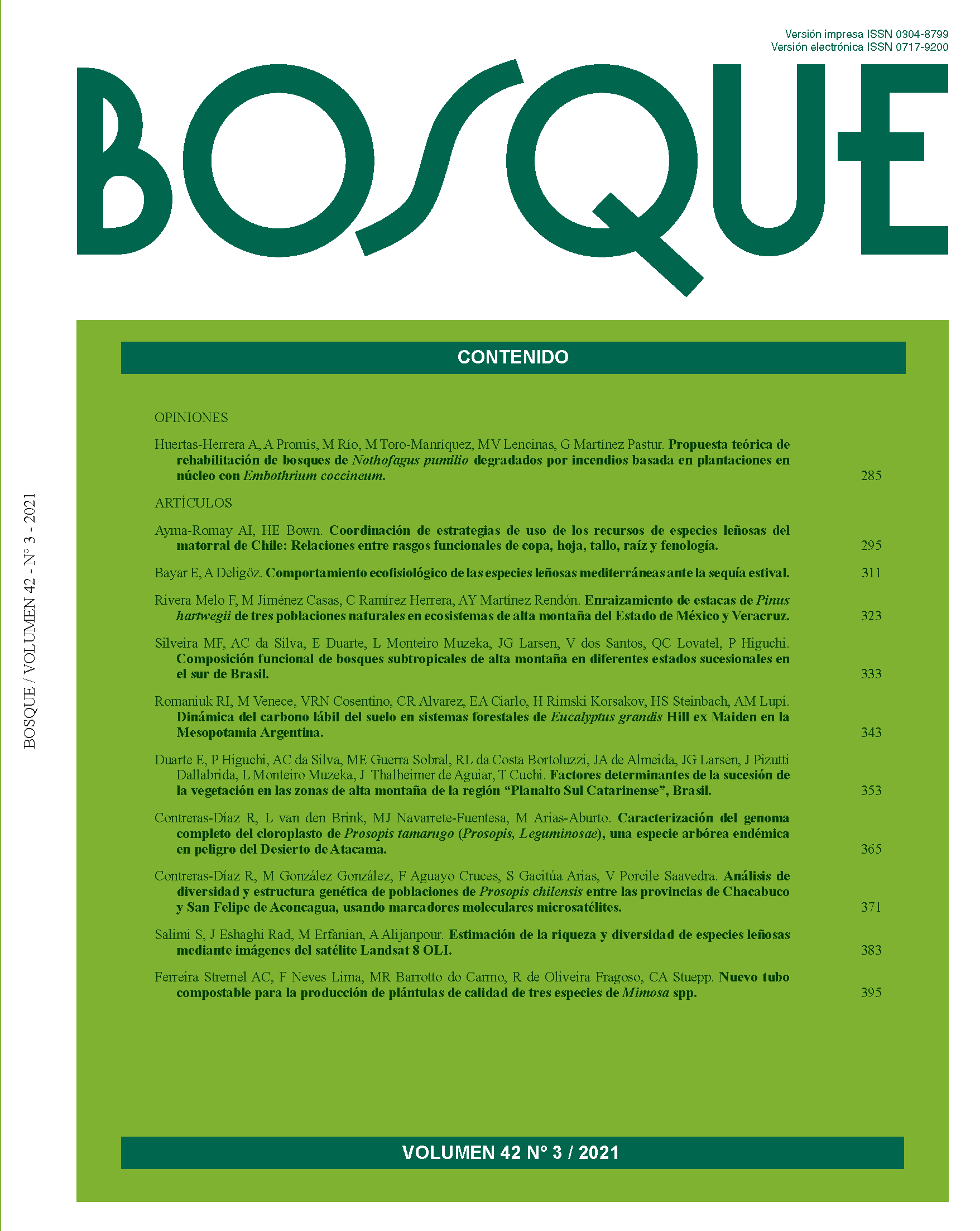Ver ítem
- xmlui.general.dspace_homeCentros Regionales y EEAsCentro Regional Patagonia SurEEA Santa CruzArtículos científicosxmlui.ArtifactBrowser.ItemViewer.trail
- Inicio
- Centros Regionales y EEAs
- Centro Regional Patagonia Sur
- EEA Santa Cruz
- Artículos científicos
- Ver ítem
Is there a relationship between the concentration of nutrients in leaves and the class of site where Nothofagus antarctica forests growth in southern Patagonia, Argentina? = ¿Existe relación entre la concentración de nutrientes en hojas con la clase sitio donde se desarrollan los bosques de Nothofagus antarctica en Patagonia sur, Argentina?
Resumen
The objective of this study was to determine whether differences in site quality correlate with better leaf nutritional status in pure Nothofagus antarctica (ñire) forests. Nine pure ñire stands of the three site classes (SC) were selected to represent the most representative sites (97 % of the total area of these forests) of the southern Patagonia region. At each study site, fully expanded leaves (mature and green) were collected from five dominant trees
[ver mas...]
The objective of this study was to determine whether differences in site quality correlate with better leaf nutritional status in pure Nothofagus antarctica (ñire) forests. Nine pure ñire stands of the three site classes (SC) were selected to represent the most representative sites (97 % of the total area of these forests) of the southern Patagonia region. At each study site, fully expanded leaves (mature and green) were collected from five dominant trees in each stand. These leaves were washed and subsequently oven dried, weighed, and ground prior to macro (C, Ca, K, Mg, N, P, and S) and micro element (Al, Fe, Mn, and Na) determination. Additionally, three composite samples (from five subsamples) of the first 20 cm of soil were collected from each site and processed for macro- and micro-element determination. Macro-nutrient concentrations in leaves varied between site classes (SC) in some elements such as K, Mg, N, P, and S, with a trend to be lower in the worse SC. In the case of soil macronutrients, all the evaluated elements showed the lowest values in the SC 5 stands. Thus, soil and leaf concentrations were significantly and positively correlated with N, P, and S. Conversely, Al, Fe, and Mn concentrations in leaves were lower in the best site class stand. With this information, we can suggest that the best classes of forests in southern Patagonia were positively associated with higher values of some macronutrients and negatively associated with some microelements.
[Cerrar]
El objetivo de este estudio fue determinar si la diferencia en la calidad del sitio se correlaciona con un mejor estado nutricional foliar en bosques puros de Nothofagus antarctica. Se seleccionaron nueve rodales puros de N. antarctica de tres clases de sitio (CS), expresando los sitios más representativos (97 % de la superficie total de estos bosques) de la región sur de la Patagonia. En cada sitio de estudio se recolectaron hojas completamente
[ver mas...]
El objetivo de este estudio fue determinar si la diferencia en la calidad del sitio se correlaciona con un mejor estado nutricional foliar en bosques puros de Nothofagus antarctica. Se seleccionaron nueve rodales puros de N. antarctica de tres clases de sitio (CS), expresando los sitios más representativos (97 % de la superficie total de estos bosques) de la región sur de la Patagonia. En cada sitio de estudio se recolectaron hojas completamente expandidas (maduras y verdes) de cinco árboles dominantes en cada rodal. Estas hojas fueron lavadas, posteriormente secadas al horno, pesadas y molidas antes de la determinación de macro (C, Ca, K, Mg, N, P y S) y microelementos (Al, Fe, Mn y Na). Además, se recogieron tres muestras compuestas (de cinco submuestras) de los primeros 20 cm de los suelos de cada lugar y se procesaron para la determinación de macro y microelementos. Las concentraciones de macronutrientes en hojas variaron entre CS en algunos elementos como K, Mg, N, P y S, con una tendencia a ser menores en las peores CS. En el caso de los macronutrientes del suelo, todos los elementos evaluados mostraron los valores más bajos en los rodales de peor CS. Así, las concentraciones en suelo y hojas estuvieron significativa y positivamente correlacionadas para N, P y S. Por otro lado, las concentraciones de Al, Fe y Mn en hojas fueron menores en el rodal de mejor clase de sitio. Con esta información podemos sugerir que las mejores clases de bosques de ñire en el sur de la Patagonia están asociadas positivamente con valores más altos de algunos macro nutrientes y negativamente con algunos micro elementos.
[Cerrar]

Autor
Bahamonde, Hector Alejandro;
Frangi, Jorge L.;
Peri, Pablo Luis;
Fuente
Bosque [Valdivia] 46 (1) : 99-109. (2025)
Fecha
2025-06
Editorial
Universidad Austral de Chile
ISSN
0717-9200 (versión en línea)
0304-8799 (versión impresa)
0304-8799 (versión impresa)
Formato
pdf
Tipo de documento
artículo
Palabras Claves
Derechos de acceso
Abierto
 Excepto donde se diga explicitamente, este item se publica bajo la siguiente descripción: Creative Commons Attribution-NonCommercial-ShareAlike 2.5 Unported (CC BY-NC-SA 2.5)
Excepto donde se diga explicitamente, este item se publica bajo la siguiente descripción: Creative Commons Attribution-NonCommercial-ShareAlike 2.5 Unported (CC BY-NC-SA 2.5)


